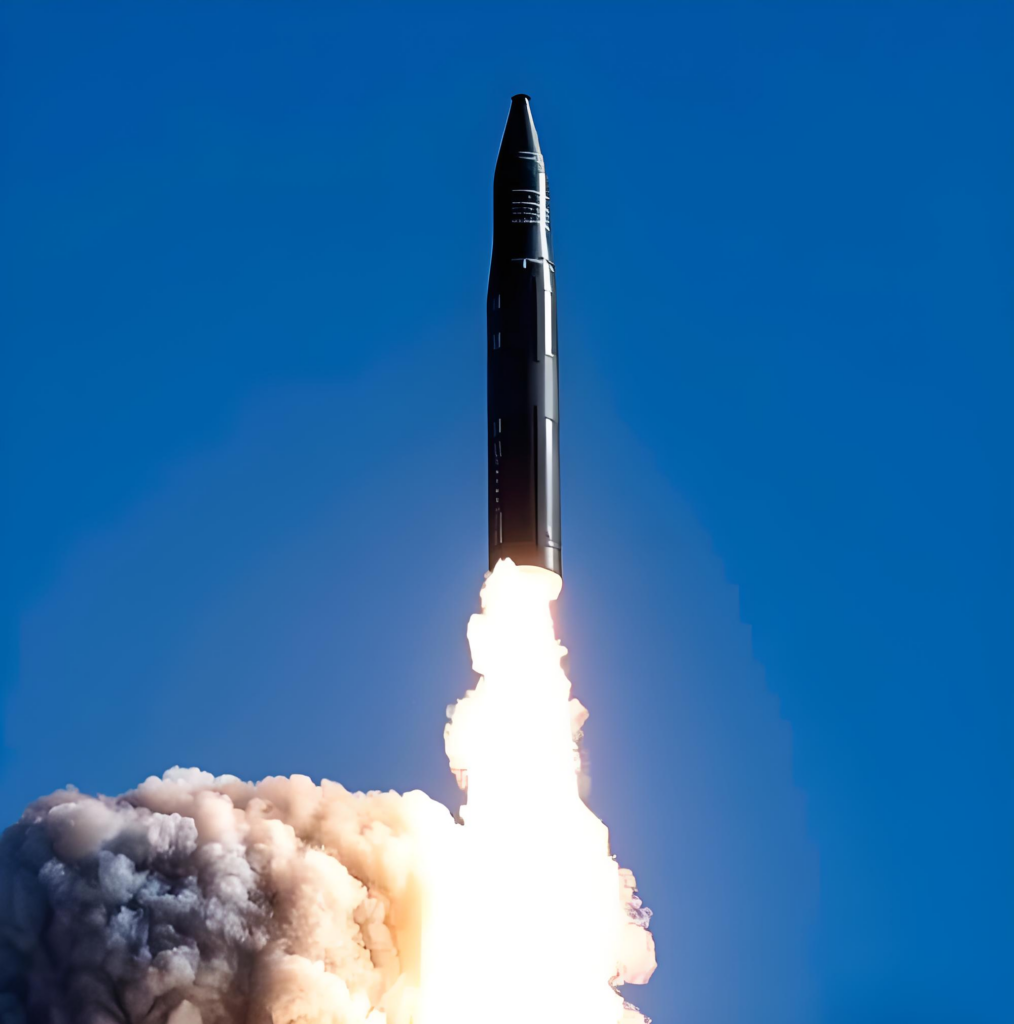On September 25, the People’s Liberation Army of China successfully launched an intercontinental ballistic missile, and the Pentagon stated that advance notification helps reduce the risk of misjudgment.
Missile Launch Overview
On September 25 at 8:44 AM, the Rocket Force of the People’s Liberation Army of China successfully launched an intercontinental ballistic missile (ICBM) carrying a training simulation warhead in the relevant high seas of the Pacific Ocean. This launch was part of an annual military training exercise aimed at testing the performance of weaponry and the training level of the troops, achieving its intended objectives. This missile launch marks further maturation of China’s ICBM technology, showcasing its increasingly strengthened strategic deterrent capabilities.
Prior to the launch, China communicated necessary information to relevant countries and international organizations to ensure transparency and reduce the risk of misjudgment. The Pentagon remarked that advance notification is a step in the right direction that helps avoid misunderstandings.

Background on Missile Technology
China’s intercontinental ballistic missile (ICBM) technology has made significant advancements in recent years, particularly in rocket technology, guidance systems, and warhead design. According to external analysis, the existing Dongfeng-5 and Dongfeng-31 series of ICBMs possess long-range strike capabilities with ranges up to 12,000 kilometers. This enables China to target many countries, including the United States, further enhancing its strategic deterrent capabilities.
Dongfeng-5 and Dongfeng-31
- Dongfeng-5: As China’s first ICBM capable of carrying nuclear warheads, the Dongfeng-5 had its first launch in 1980. After multiple improvements, it now possesses high precision and strong survivability. The latest version has significantly enhanced range and strike accuracy, effectively countering enemy missile defense systems.
- Dongfeng-31: The Dongfeng-31 is a new generation of Chinese ICBMs that features good mobility and concealment. It can be launched from mobile launchers, increasing its survivability. Additionally, the Dongfeng-31A variant employs multiple warhead technology, allowing it to strike multiple targets in a single launch, significantly enhancing its strike capability.

International Economic Impact
Changes in Trade Relations
- Background: The intercontinental missile launch may raise doubts among other countries regarding China’s military intentions, particularly concerning products related to technology and security.
- Specific Impact: Some countries may strengthen regulations on exports to China, especially in high-tech, electronics, and military-related materials. This could lead to a decrease in China’s competitiveness in the global market, affecting export revenue, particularly in key markets like the U.S. and Europe.
Fluctuations in the Investment Environment
- Background: Military tensions typically make investors wary about market stability.
- Specific Impact: International investors may reduce direct investment in China due to concerns about its military developments, especially in manufacturing and high-tech sectors. This could result in delays or withdrawals of investment projects, subsequently impacting China’s economic growth rate and foreign investment inflow.
Geopolitical Tensions
- Background: The missile launch is perceived as a deterrent, potentially prompting military expansion among neighboring countries.
- Specific Impact: Regional countries such as Japan, India, and those in Southeast Asia may increase their military expenditures or seek to strengthen military cooperation with Western countries like the U.S., leading to new military confrontations. This geopolitical shift will have far-reaching implications for the global economic landscape, potentially triggering economic sanctions or trade restrictions.
Risk of International Sanctions
- Background: Military actions may provoke responses from other countries, particularly within the framework of the United Nations.
- Specific Impact: If the UN or specific countries impose economic sanctions on China, this would directly impact China’s international trade, investment inflows, and financial transactions, leading to slower economic growth and diminished market confidence.
Adjustments in Technological Cooperation
- Background: National security issues can affect international technological exchanges.
- Specific Impact: Some countries may suspend or reduce cooperative projects with China in high-tech fields such as 5G, artificial intelligence, and aerospace. This not only affects China’s technological advancement but may also result in technological bottlenecks and loss of market opportunities in related industries.

Domestic Economic Impact
Thriving Military Industry
- Background: The missile launch demonstrates China’s advancements in military technology, prompting increased government investment.
- Specific Impact: Orders and investments in military enterprises are expected to rise significantly, benefiting related industries such as materials, electronic components, and manufacturing equipment, thereby promoting overall economic growth. With rising demand, numerous job opportunities may emerge, enhancing the training of technical talent and improving technological standards.
Increased Defense Budget
- Background: Enhancing defense capabilities is necessary to respond to changing international dynamics.
- Specific Impact: The increased defense budget may divert resources from sectors like education, healthcare, and infrastructure. This reallocation of resources could lead to social discontent and impact the long-term sustainability of the economy.
Promotion of Technological Innovation
- Background: The development of military technology requires substantial innovation.
- Specific Impact: Policies fostering military-civilian integration will promote the transfer of military technologies to civilian sectors, driving the growth of high-tech industries. This will further facilitate China’s economic restructuring and enhance the nation’s overall technological level and innovation capacity.
Impact on Domestic Consumption
- Background: Heightened national security awareness may influence consumer behavior.
- Specific Impact: The government may encourage consumers to spend on security products and services, such as protective equipment and security services, spurring growth in related industries. This shift in consumption patterns could also affect consumer confidence and economic sentiment.
Adjustment of Economic Policies
- Background: In light of the complex international situation, China may reassess its economic development strategy.
- Specific Impact: The government might adopt more protectionist measures to encourage domestic industry development and reduce external dependencies. This could alter the structure of foreign trade, prompting domestic companies to shift towards the domestic market, while also potentially provoking dissatisfaction in the international community and affecting trade relations.

Technological Advancements and Modernization
China’s ongoing investment in intercontinental missile technology has significantly enhanced the modernization of its weapon systems. For instance, the new generation of missiles employs advanced materials and design concepts, improving both range and warhead survivability. Additionally, advancements in guidance technology have notably increased missile precision, enabling high-accuracy strikes.
International Reactions and Strategic Significance
This missile launch has attracted widespread international attention. U.S. officials stated that this action contributes to reducing misjudgment and reflects progress in military transparency between the parties. However, Western countries remain vigilant about China’s missile development, expressing concerns about its potential impact on regional security dynamics.
U.S. Strategic Response
In response to China’s growing military capabilities, the United States has implemented a series of countermeasures, including:
- Strengthening Military Cooperation: The U.S. has enhanced military cooperation with allies in the Asia-Pacific region to bolster its strategic presence. This includes strengthening military exercises and joint training with Japan, South Korea, and Australia to improve the defensive capabilities of regional allies.
- Updating Missile Defense Systems: The U.S. is enhancing its missile defense capabilities globally, including deploying advanced THAAD and Aegis systems in the Asia-Pacific region to improve its response to Chinese missile threats.
- Strategic Deterrence: The U.S. continues to advance its nuclear deterrence policy, maintaining a sufficient nuclear force to ensure deterrence against potential adversaries.

Reactions from Other Asian Countries
In addition to the United States, other Asia-Pacific countries such as Japan, South Korea, and India have also expressed concern regarding China’s missile launch. Many nations worry that as China’s military power increases, regional security dynamics may become more complex, prompting them to seek ways to enhance their own defense capabilities and cooperation with allies like the U.S.
For instance, India has significantly increased its investment in missile development in recent years, aiming to strategically counterbalance China. Meanwhile, Japan and South Korea are considering greater reliance on U.S. forces and accelerating the development of their own missile defense systems.
Legal and Ethical Considerations of Missile Launches
The legal and ethical issues surrounding missile launches are also noteworthy. Under international law, nations have the right to self-defense and conduct defensive weapon tests. However, the proliferation of missile technology and the potential use of nuclear weapons continue to raise concerns within the international community.
International Legal Framework
International oversight of missile launches is primarily reflected in agreements such as the Treaty on the Non-Proliferation of Nuclear Weapons (NPT) and the Missile Technology Control Regime (MTCR). These agreements aim to limit the spread of nuclear weapons and missile technology to maintain global security. However, as technology continues to advance, many countries face challenges in their efforts for arms control and disarmament.
Moral Responsibility
In an era of rapidly advancing military technology, countries must assume corresponding moral responsibilities when conducting missile tests, ensuring that such tests do not pose threats to other nations or regions and maintaining international security and stability. While enhancing their own military capabilities, nations should also consider the concerns of the international community and work towards establishing a more just and transparent international security mechanism.

Future Outlook
As technology continues to progress, China’s intercontinental missile capabilities will likely strengthen further. We may see the development and deployment of more advanced missiles, further enhancing China’s position in the global strategic landscape. For instance, future intercontinental missiles might incorporate hypersonic technology to improve their penetration capabilities.
At the same time, the international community needs to enhance communication and cooperation to resolve potential conflicts and friction through dialogue and negotiation. Countries should work together to maintain peace and stability both regionally and globally. Strengthening military transparency and establishing trust mechanisms should be common goals pursued by all nations.
The recent successful launch of an intercontinental missile by China not only showcases its enhanced military capabilities but also prompts attention and discussion within the international community. In the future of international relations, countries need to prioritize transparency and communication while developing their military capabilities to reduce misunderstandings and conflicts, thereby safeguarding global security. Through proactive diplomatic efforts, nations should strive to create a secure and stable international environment, ensuring the potential for peaceful development in the future.
